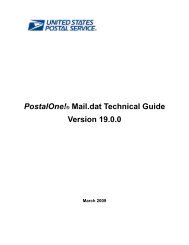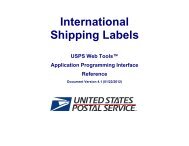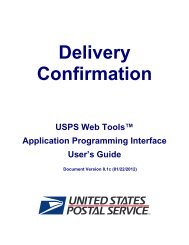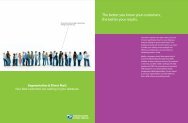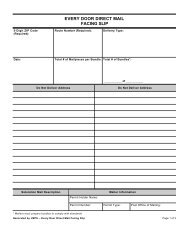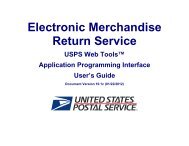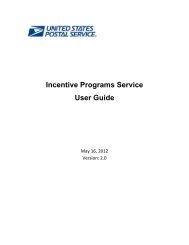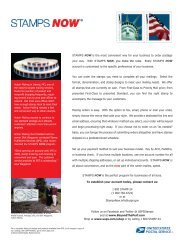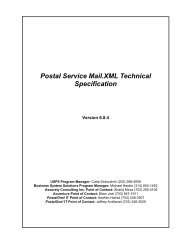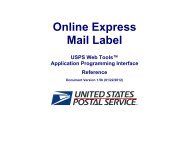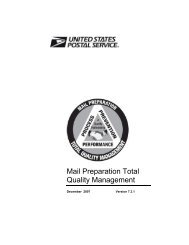Development Guide for USPS Webtools API Services
Development Guide for USPS Webtools API Services
Development Guide for USPS Webtools API Services
Create successful ePaper yourself
Turn your PDF publications into a flip-book with our unique Google optimized e-Paper software.
United States Postal Service<br />
Web Tool Kit <strong>Development</strong> <strong>Guide</strong><br />
<strong>Development</strong> <strong>Guide</strong> <strong>for</strong><br />
Application Programming Interfaces to<br />
<strong>USPS</strong> Web Tools Service<br />
In<strong>for</strong>mation and Procedures Prior to Use<br />
Document Version 3.1a (01/22/2012)
<strong>USPS</strong> Web Tool Kit <strong>Development</strong> <strong>Guide</strong><br />
To Our Customers<br />
In the e-mail from the registration process, you received a user ID that will allow you to begin<br />
sending calls to the “test server” when you are ready. Any additional documentation or contact<br />
with you will be made through the contact person indicated on the registration <strong>for</strong>m.<br />
If you require technical support, contact the <strong>USPS</strong> Internet Customer Care Center (ICCC). This<br />
office operates from 7:00AM to 11:00PM EST.<br />
E-mail: uspstechsupport@esecurecare.net<br />
Telephone: 1-800-344-7779 (7:00AM to 11:00PM EST)<br />
<strong>USPS</strong> Customer Commitment<br />
The United States Postal Service fully understands the importance of providing in<strong>for</strong>mation and<br />
service anytime day or night to your Internet and e-commerce customers. For that reason, the<br />
<strong>USPS</strong> is committed to providing 24 x 7 service from our <strong>API</strong> servers, 365 days a year.<br />
Thank you <strong>for</strong> helping the U.S. Postal Service provide new Internet services to our shipping<br />
customers.<br />
Internet Shipping Solutions Team<br />
U.S. Postal Service<br />
475 L’Enfant Plaza, SW<br />
Washington, DC 20260-2464<br />
Trademarks<br />
Express Mail, First-Class Mail, Parcel Post, Priority Mail, and ZIP + 4 are registered trademarks<br />
of the U.S. Postal Service.<br />
Delivery Confirmation, Global Express Guaranteed, GXG, Signature Confirmation, and ZIP<br />
Code are trademarks of the U.S. Postal Service.<br />
Microsoft and Word are registered trademarks of Microsoft Corporation.<br />
Adobe Acrobat is a trademark of Adobe Systems Incorporated.<br />
�Copyright 2012 United States Postal Service<br />
<strong>Development</strong> <strong>Guide</strong> <strong>for</strong> <strong>API</strong>s (v. 3.1a) i
<strong>USPS</strong> Web Tool Kit <strong>Development</strong> <strong>Guide</strong><br />
Table of Contents<br />
Introduction ................................................................................................1<br />
User ID Restrictions .................................................................................................. 1<br />
<strong>USPS</strong> Corporate Branding <strong>Guide</strong>lines..................................................................... 2<br />
Preferred Reference............................................................................................................2<br />
Alternative Reference ......................................................................................................... 2<br />
Registered Trademarks ...................................................................................................... 3<br />
Trademark Ownership and Use ......................................................................................... 3<br />
Getting Started ...........................................................................................4<br />
Administrative Steps................................................................................................. 4<br />
Step 1: Register................................................................................................................... 4<br />
Step 2: Obtain a Merchandise Return Service Permit ..................................................... 4<br />
Step 3: Run “Canned” Test from Test Server................................................................... 5<br />
Step 4: Call ICCC <strong>for</strong> Access to Production Server......................................................... 5<br />
Step 5: Run “Samples” from Production Server.............................................................. 5<br />
Step 6: Submit “Samples” to the <strong>USPS</strong> <strong>for</strong> Printer Certification.................................... 6<br />
Step 7: Receive Printer Approval from ICCC.................................................................... 6<br />
Step 8: Run “Live” XML from Production Server............................................................. 7<br />
Step 9: Maintain 95% Printer Quality or Lose Access ..................................................... 7<br />
Administrative Forms................................................................................................ 7<br />
Electronic Merchandise Return Service Notification..................................................... 10<br />
Technical Instructions .............................................................................11<br />
Client Protocols ....................................................................................................... 11<br />
XML Overview .......................................................................................................... 11<br />
Software <strong>Development</strong>............................................................................................ 12<br />
Error Handling ......................................................................................................... 12<br />
Testing...................................................................................................................... 13<br />
Starter <strong>API</strong>s........................................................................................................................ 13<br />
Testing Tips ....................................................................................................................... 18<br />
Updates to <strong>API</strong>s ....................................................................................................... 19<br />
References ............................................................................................................... 20<br />
CODE Example ........................................................................................................ 20<br />
<strong>Development</strong> <strong>Guide</strong> <strong>for</strong> <strong>API</strong>s (v. 3.1a) ii
Introduction<br />
<strong>USPS</strong> Web Tool Kit <strong>Development</strong> <strong>Guide</strong><br />
The <strong>USPS</strong> Web Tool Kit Application Program Interfaces (<strong>API</strong>s) allow developers of web-based<br />
and shrink-wrapped applications access to the on-line services of the United States Postal<br />
Service (<strong>USPS</strong>). They provide easy access to shipping in<strong>for</strong>mation and services <strong>for</strong> your<br />
customers. By integrating these <strong>API</strong>s into your web site, your customers can utilize the<br />
functions provided by the <strong>USPS</strong> without ever leaving your web site. Once the <strong>API</strong>s are<br />
integrated into your web site, the <strong>USPS</strong> Shipping <strong>API</strong> Server communicates over HTTP using<br />
XML (Extensible Markup Language).<br />
Implementing these <strong>API</strong>s requires experienced programmers who are familiar with Internet<br />
and web site development tools and techniques.<br />
This document provides guidance and step-by-step instructions <strong>for</strong> installing the <strong>USPS</strong> <strong>API</strong>s, as<br />
well as fulfilling various administrative requirements. The administrative requirements vary<br />
between different <strong>API</strong>s (e.g., submitting samples of labels <strong>for</strong> some <strong>API</strong>s, signing a licensing<br />
agreement <strong>for</strong> certain software, etc.), and this document provides guidance to navigate through<br />
the process <strong>for</strong> the <strong>API</strong> you are implementing. It is imperative that developers read this manual<br />
first, as it provides necessary in<strong>for</strong>mation and procedures prior to use.<br />
There is a Web Tool Kit User’s <strong>Guide</strong> <strong>for</strong> each <strong>API</strong> available at http://www.usps.com/webtools/.<br />
These user guides provide in<strong>for</strong>mation of the XML transactions to the <strong>USPS</strong> Shipping <strong>API</strong><br />
server.<br />
User ID Restrictions<br />
The user ID that you have received is <strong>for</strong> you or your company to use in accordance with the<br />
Terms and Conditions of Use to which you agreed during the registration process. This user ID<br />
is not to be shared with others outside your organization, nor is it to be packaged, distributed, or<br />
sold to any other person or entity. Please refer to the Terms and Conditions of Use Agreement<br />
<strong>for</strong> additional restrictions on the use of your user ID, as well as this document and the <strong>API</strong>s<br />
contained herein.<br />
Warning: If the U.S. Postal Service discovers use of the same user ID from more than one web<br />
site, all users will be subject to immediate loss of access to the <strong>USPS</strong> server and termination of<br />
the licenses granted under the Terms and Conditions of Use.<br />
The documentation and sample code contained in the Web Tool Kit User <strong>Guide</strong> series may be<br />
reused and/or distributed to your customers or affiliates to generate awareness, encourage web<br />
tool use, or provide ease-of-use. However, it is your responsibility to ensure that your customers<br />
do not use your user ID. Direct your users to www.usps.com/webtools/ so that they can register,<br />
agree to the Terms and Conditions of Use agreement, and receive their own unique user ID.<br />
Note to Software Distributors: The User ID restrictions discussed above are intended <strong>for</strong> e-tailers<br />
that use the <strong>USPS</strong> Web Tools exclusively within their own web sites. If you plan to distribute<br />
software with the <strong>USPS</strong> Web Tools embedded, you must refer to the “Software Developers’<br />
Terms and Conditions of Use” available at http://www.usps.com/webtools/.<br />
<strong>Development</strong> <strong>Guide</strong> <strong>for</strong> <strong>API</strong>s (v. 3.1a) 1
<strong>USPS</strong> Web Tool Kit <strong>Development</strong> <strong>Guide</strong><br />
For more in<strong>for</strong>mation regarding the <strong>USPS</strong> Web Tool Kit user ID policy, or <strong>for</strong> questions<br />
regarding the distribution of documentation, send an e-mail to the Internet Customer Care Center<br />
(ICCC) at uspstechsupport@esecurecare.net.<br />
<strong>USPS</strong> Corporate Branding <strong>Guide</strong>lines<br />
The U.S. Postal Service requests that it is referenced and acknowledged as the source of<br />
in<strong>for</strong>mation <strong>for</strong> all U.S. Postal Service data that has been acquired through the Internet and/or<br />
from other sources. However, this is not mandatory. The following guidelines should be<br />
followed <strong>for</strong> those that want to authenticate and/or validate the data displayed from the U.S.<br />
Postal Service.<br />
Preferred Reference<br />
Use one of the following when the <strong>USPS</strong> is the only referenced source:<br />
� “In<strong>for</strong>mation provided by www.usps.com”<br />
or<br />
� use the official <strong>USPS</strong> corporate logo or <strong>USPS</strong> product-specific logos.<br />
Digital copies of <strong>USPS</strong> corporate trademarks/logos are available through the U.S. Postal Service,<br />
Public Policy and Communications Department, Washington, D.C. You can request the <strong>USPS</strong><br />
corporate logo and/or product-specific logos by e-mailing ilogo@email.usps.gov. Requests will<br />
be responded to by e-mail within 10 days. We will review your web site, and if appropriate,<br />
provide the logo <strong>for</strong> usage in accordance with these guidelines and the license grant contained in<br />
the Terms and Conditions of Use <strong>for</strong> Internet Shipping Application Program Interfaces (<strong>API</strong>s).<br />
If your web page is not available over the Internet, please provide a screen shot of the page<br />
where the logo will reside.<br />
When requesting logo(s) you must provide the following in<strong>for</strong>mation:<br />
� company name<br />
� URL and page where logo will reside<br />
� type of business<br />
� how and where the logo will be used<br />
� contact name<br />
� telephone number<br />
� e-mail address<br />
� desired graphic <strong>for</strong>mat, e.g., GIF, TIF, JPEG, etc.<br />
� logo desired:<br />
____<strong>USPS</strong> Corporate Eagle Logo<br />
____Express Mail<br />
____Priority Mail<br />
____other (describe)<br />
Alternative Reference<br />
Use one of the following when the <strong>USPS</strong> is listed with other shipping carriers or web sites:<br />
<strong>Development</strong> <strong>Guide</strong> <strong>for</strong> <strong>API</strong>s (v. 3.1a) 2
<strong>USPS</strong> Web Tool Kit <strong>Development</strong> <strong>Guide</strong><br />
� United States Postal Service<br />
� U.S. Postal Service<br />
� U.S.P.S. (use period after each initial)<br />
The above alternatives are listed in the order of U.S. Postal Service preference.<br />
Examples:<br />
“U.S. Postal Service delivery standard is two days.”<br />
“U.S.P.S. Priority Mail rate is $3.95.”<br />
Registered Trademarks<br />
The <strong>USPS</strong> trademarks listed on page i, as well as any logos requested from <strong>USPS</strong> Public Policy<br />
and Communications Department, should not be altered or abbreviated. You can request<br />
product-specific logos by e-mailing ilogo@email.usps.gov.<br />
Trademark Ownership and Use<br />
<strong>USPS</strong> trademarks are trademarks owned solely and exclusively by <strong>USPS</strong> and may be used only<br />
in the <strong>for</strong>m, manner and with appropriate legends prescribed by <strong>USPS</strong>. All advertising and other<br />
uses of <strong>USPS</strong> trademarks must include a legend indicating that <strong>USPS</strong> trademarks are the<br />
property of <strong>USPS</strong> and that they are being used under license from <strong>USPS</strong>, together with any other<br />
legends or marking that may be required by law. Nothing contained in this document shall be<br />
deemed to convey any title or ownership interest to any user except <strong>for</strong> the nonexclusive rights<br />
granted under the Terms and Conditions of Use <strong>for</strong> Internet Shipping Application Program<br />
Interfaces and this document. All use of <strong>USPS</strong> Trademarks shall inure to the benefit of <strong>USPS</strong>.<br />
<strong>Development</strong> <strong>Guide</strong> <strong>for</strong> <strong>API</strong>s (v. 3.1a) 3
Getting Started<br />
Administrative Steps<br />
<strong>USPS</strong> Web Tool Kit <strong>Development</strong> <strong>Guide</strong><br />
For each step described below, it is indicated which of the <strong>API</strong>s listed in the Introduction section<br />
requires the action(s) in the step. Many of the steps apply to all <strong>API</strong>s.<br />
Step 1: Register<br />
Applicable <strong>API</strong>s: All<br />
To use the <strong>USPS</strong> <strong>API</strong>s you must be a registered user. If you have not registered, go to<br />
http://www.usps.com/webtools/ and follow the instructions to register <strong>for</strong> the <strong>API</strong>s.<br />
Upon completion the registration process, your user ID and test <strong>API</strong> server URL will be sent via<br />
e-mail to the address specified in the registration. Please refer to the Restrictions on page 1 <strong>for</strong><br />
an important notice regarding the use of your user ID.<br />
Step 2: Obtain a Merchandise Return Service Permit<br />
Applicable <strong>API</strong>s:<br />
Electronic Merchandise Return Service and<br />
Electronic Merchandise Return Service with Delivery Confirmation<br />
This step is only required if you are implementing the Electronic Merchandise Return (EMRS)<br />
Service <strong>API</strong> (with or without Delivery Confirmation). If you are implementing any other <strong>API</strong>,<br />
skip this step.<br />
A Merchandise Return Service permit is required <strong>for</strong> Electronic Merchandise Return Service.<br />
Merchandise Return Service may be established at any post office in the United States and its<br />
territories and possessions, or at any U.S. military post office overseas (APO/FPO). It is not<br />
available <strong>for</strong> any <strong>for</strong>eign country.<br />
If you do not have a valid Merchandise Return Service permit, you need to submit the following<br />
items to the local post office that will be delivering your return merchandise:<br />
1. a completed <strong>USPS</strong> Form 3615<br />
2. payment <strong>for</strong> the annual permit fee<br />
3. the sample Electronic Merchandise Return Service Notification label provided in the<br />
Administrative Forms section.<br />
Print the Notification label and submit to your local post office as is. Do not alter the image.<br />
<strong>Development</strong> <strong>Guide</strong> <strong>for</strong> <strong>API</strong>s (v. 3.1a) 4
<strong>USPS</strong> Web Tool Kit <strong>Development</strong> <strong>Guide</strong><br />
Important: When printing PDF files with barcodes, be sure that the<br />
"Fit to Page" option in the print dialogue box of Adobe Acrobat Reader is unchecked.<br />
Step 3: Run “Canned” Test from Test Server<br />
Applicable <strong>API</strong>s: All<br />
The next step is to test your <strong>API</strong> interfaces. As a registered <strong>API</strong> user you have been granted<br />
access to the Shipping <strong>API</strong> test server. An important note: the test server is set up to only<br />
accept a subset of pre-defined XML transactions and return the pre-defined XML responses<br />
provided in this document.<br />
If you have already successfully tested your <strong>API</strong> and have access to the production server, skip<br />
this step and proceed to Step 5: Run “Samples” from Production Server.<br />
For the testing phase, follow the Technical Instructions section below.<br />
Step 4: Call ICCC <strong>for</strong> Access to Production Server<br />
Applicable <strong>API</strong>s: All<br />
Once you have run your XML test transactions and have confirmed the XML responses, contact<br />
the Internet Customer Care Center (ICCC) (e-mail: uspstechsupport@esecurecare.net; telephone:<br />
1-800-344-7779 (7:00AM to 11:00PM EST)) and request activation to the Shipping <strong>API</strong><br />
production server. The ICCC will validate you <strong>for</strong> production access and will provide the<br />
Shipping <strong>API</strong> production server URL.<br />
Once you have been validated by the ICCC, you will be able to connect to the Shipping <strong>API</strong><br />
production server. Unlike the test server, the production server will accept live data. Note that<br />
once you have access to the production server you may still test against the test server.<br />
Step 5: Run “Samples” from Production Server<br />
Applicable <strong>API</strong>s:<br />
Delivery Confirmation, Signature Confirmation and<br />
Electronic Merchandise Return Service with Delivery Confirmation<br />
If your labels have already been approved by the <strong>USPS</strong> National Customer Support Center<br />
(NCSC), you are ready to begin sending “live” requests. If so, skip this step and proceed to Step<br />
8: Run “Live” XML from Production Server. If you are implementing any <strong>API</strong> other than<br />
Delivery Confirmation, skip to Step 8: Run “Live” XML from Production Server.<br />
<strong>Development</strong> <strong>Guide</strong> <strong>for</strong> <strong>API</strong>s (v. 3.1a) 5
<strong>USPS</strong> Web Tool Kit <strong>Development</strong> <strong>Guide</strong><br />
Implementing the Delivery Confirmation, Signature Confirmation, and Electronic Merchandise<br />
Return Service with Delivery Confirmation <strong>API</strong>s requires this additional interim step. At this<br />
stage of the process, you are only authorized to send the “Sample” data (provided in the<br />
“Sample” Request section in the Web Tool Kit User's <strong>Guide</strong> <strong>for</strong> the <strong>API</strong> you are installing) to the<br />
production server. You must have samples of the labels produced on your printer certified<br />
be<strong>for</strong>e being able to use the <strong>API</strong> in full production mode. This is to demonstrate that your printer<br />
is capable of printing legible barcodes that are readable by <strong>USPS</strong> scanning equipment.<br />
Questions about the label printer certification process may be directed to NCSC support staff at<br />
(800) 279-2651. Be sure to mention that you are a Web Tool Kit <strong>API</strong> customer.<br />
Step 6: Submit “Samples” to the <strong>USPS</strong> <strong>for</strong> Printer Certification<br />
Applicable <strong>API</strong>:<br />
Delivery Confirmation, Signature Confirmation,<br />
Electronic Merchandise Return Service with Delivery Confirmation, All<br />
Global Labels<br />
Implementing the Delivery Confirmation and Electronic Merchandise Return Service with<br />
Delivery Confirmation <strong>API</strong>s requires this additional interim step. To complete the certification<br />
process <strong>for</strong> your barcoded labels, take the following steps:<br />
1. Send the “Sample” XML request provided in the Web Tool Kit User's <strong>Guide</strong> <strong>for</strong> the <strong>API</strong> you<br />
are installing to the Shipping <strong>API</strong> production server. Be sure to input your own “live” data in<br />
the request. The output returned to you will be a sample label <strong>for</strong> certification purposes.<br />
Repeat this 10 times with different sample data each time. You must have 10 different<br />
“Sample” labels with 10 different barcodes and PIC numbers.<br />
2. Print the ten “Sample” labels with barcode and PIC numbers returned to you.<br />
3. Complete the <strong>USPS</strong> <strong>API</strong> Printer Certification Submission <strong>for</strong>m in the Administrative Forms<br />
section and mail, along with the ten barcoded labels, to:<br />
National Customer Support Center<br />
Attn: Barcode Certification - Web Tools (<strong>API</strong>)<br />
U.S. Postal Service<br />
6060 Primacy Pkwy, Suite 201<br />
Memphis, TN 38188-0001<br />
You can either print the <strong>for</strong>m from this PDF file and fill out with a pen, or copy the <strong>for</strong>m to a<br />
Microsoft Word file and fill out electronically be<strong>for</strong>e printing and signing.<br />
Step 7: Receive Printer Approval from ICCC<br />
Applicable <strong>API</strong>s:<br />
Delivery Confirmation, Signature Confirmation, and<br />
Electronic Merchandise Return Service with Delivery Confirmation<br />
<strong>Development</strong> <strong>Guide</strong> <strong>for</strong> <strong>API</strong>s (v. 3.1a) 6
<strong>USPS</strong> Web Tool Kit <strong>Development</strong> <strong>Guide</strong><br />
Implementing the Delivery Confirmation and Electronic Merchandise Return Service with<br />
Delivery Confirmation <strong>API</strong>s requires this additional interim step. The NCSC will review your<br />
labels within two business days. If the labels fail the certification test, the NCSC will contact the<br />
person listed on the submission <strong>for</strong>m directly. If the labels pass, you will be notified by the<br />
Internet Customer Care Center and you will be able to send XML transactions using your “live”<br />
data and receive “live” responses.<br />
Once you are approved to generate “live” labels from the production server, and you need to<br />
print additional test labels <strong>for</strong> any reason, be sure to use the “Sample” XML request. Otherwise,<br />
the <strong>USPS</strong> will send a manifest of the PIC numbers issued to the <strong>USPS</strong> Postal Tracking System<br />
and will be looking <strong>for</strong> the Delivery Confirmation labels to scan.<br />
Step 8: Run “Live” XML from Production Server<br />
Applicable <strong>API</strong>s: All<br />
At this point, you have completed all testing and are now ready to send “live” data to the<br />
production server and begin full <strong>API</strong> service. The Web Tool Kit User's <strong>Guide</strong> <strong>for</strong> the <strong>API</strong> you<br />
are using has XML schema in<strong>for</strong>mation.<br />
Step 9: Maintain 95% Printer Quality or Lose Access<br />
Applicable <strong>API</strong>s:<br />
Delivery Confirmation and<br />
Electronic Merchandise Return Service with Delivery Confirmation<br />
Barcodes that cannot be scanned have to be entered manually by the <strong>USPS</strong>. Delivery<br />
Confirmation users are responsible <strong>for</strong> maintaining a quality level of 95% <strong>for</strong> scannable<br />
barcodes. If you act as a third party and provide Delivery Confirmation or Signature<br />
Confirmation to others, then you are also responsible <strong>for</strong> your customers to maintain 95%<br />
readability. However, your end-users need not certify their printer. It is your responsibility to<br />
make certain that they print legible barcodes and maintain 95% readability.<br />
In the event that barcode print quality falls below the 95% quality threshold, the <strong>USPS</strong> will<br />
contact the e-tailer and an ef<strong>for</strong>t will be made to resolve the problem. The user is given 30 days<br />
to correct the problem, after which access to the Shipping <strong>API</strong> server will be suspended pending<br />
resolution. Third-party web sites that provide labels to end-users will need to maintain files<br />
(records) of the PICs generated and sent to each customer so that they can identify customers<br />
who do not comply with the 95% quality control requirements.<br />
Administrative Forms<br />
The following <strong>for</strong>ms are provided in this section:<br />
1. Licensing Agreement <strong>for</strong> the <strong>API</strong> Connector Code<br />
<strong>Development</strong> <strong>Guide</strong> <strong>for</strong> <strong>API</strong>s (v. 3.1a) 7
<strong>USPS</strong> Web Tool Kit <strong>Development</strong> <strong>Guide</strong><br />
Print the Licensing Agreement and fax the completed agreement to the <strong>USPS</strong> Internet<br />
Customer Care Center at 1-800-210-9512. Please e-mail a confirmation of your fax to<br />
uspstechsupport@esecurecare.net.<br />
2. <strong>USPS</strong> <strong>API</strong> Printer Certification Submission Form<br />
Print and complete the Printer Certification Submission <strong>for</strong>m and mail, along with the ten<br />
barcoded labels, to:<br />
National Customer Support Center<br />
Attn: Barcode Certification - Web Tools (<strong>API</strong>)<br />
U.S. Postal Service<br />
6060 Primacy Pkwy, Suite 201<br />
Memphis, TN 38188-0001<br />
You can either print the <strong>for</strong>m from this PDF file and fill out with a pen, or copy the <strong>for</strong>m to a<br />
Microsoft Word file and fill out electronically be<strong>for</strong>e printing and signing.<br />
3. Electronic Merchandise Return Service Notification Label<br />
Print the Notification label and submit to your local post office as is. Do not alter the image.<br />
There is nothing to fill out or complete.<br />
Important: When printing PDF files with barcodes, be sure that the<br />
"Fit to Page" option in the print dialogue box of Adobe Acrobat Reader is unchecked.<br />
<strong>Development</strong> <strong>Guide</strong> <strong>for</strong> <strong>API</strong>s (v. 3.1a) 8
<strong>USPS</strong> Web Tool Kit <strong>Development</strong> <strong>Guide</strong><br />
Delivery Confirmation and Signature Confirmation <strong>API</strong><br />
Submission of Customer Printed Labels <strong>for</strong> Printer Certification<br />
Ten labels must be submitted <strong>for</strong> each printer you are certifying.<br />
Company Name/Customer Name:<br />
Mailing Address:<br />
City/State/ZIP+4:<br />
Name of Contact:<br />
Phone # of Contact: FAX: e-mail:<br />
Web Tool, <strong>API</strong> User ID#:<br />
Company Web site (URL), if any:<br />
<strong>API</strong> Program Number: 805213907 (To be used by all customers)<br />
Instructions:<br />
With this <strong>for</strong>m, submit 10 labels from each printer used to print Delivery Confirmation or Signature<br />
Confirmation labels with barcodes. List the printers below with their brand names and model numbers.<br />
If certifying more than one printer, write the printer number on the first label (or attach a note) associated<br />
with the list below.<br />
Printer # Printer Brand Name Printer Model Number<br />
1<br />
2<br />
3<br />
4<br />
5<br />
6<br />
7<br />
8<br />
Signature of Contact Person Date<br />
Instructions <strong>for</strong> National Customer Support Center:<br />
Upon approval, notify the Internet Customer Care Center at (800) 344-7779 and<br />
provide customer's <strong>API</strong> User ID#.<br />
<strong>Development</strong> <strong>Guide</strong> <strong>for</strong> <strong>API</strong>s (v. 3.1a) 9
<strong>USPS</strong> Web Tool Kit <strong>Development</strong> <strong>Guide</strong><br />
Electronic Merchandise Return Service Notification<br />
Attention: Postmaster/Mailing Requirements<br />
The holder of this sample Merchandise Return Service label will be using the <strong>USPS</strong> Internet<br />
Shipping Application Program Interface (<strong>API</strong>) program to prepare and generate Merchandise<br />
Return Service labels. Please provide a Merchandise Return Service Permit as per DMM<br />
507.11.0. If you need additional in<strong>for</strong>mation regarding this program, contact the <strong>USPS</strong> Internet<br />
Customer Care Center at 1-800-344-7779.<br />
(The above image is not to scale.)<br />
<strong>Development</strong> <strong>Guide</strong> <strong>for</strong> <strong>API</strong>s (v. 3.1a) 10
Technical Instructions<br />
Client Protocols<br />
<strong>USPS</strong> Web Tool Kit <strong>Development</strong> <strong>Guide</strong><br />
HTTP/HTTPS protocols are used <strong>for</strong> exchange of data. This is to facility passage through<br />
corporate firewalls and inclusion of multiple technologies <strong>for</strong> implementation. The simple<br />
example of this is a URL in a standard browser of the <strong>for</strong>m:<br />
http://production.shippingapis.com/Shipping<strong>API</strong>.dll?<br />
<strong>API</strong>=<strong>API</strong>NAME&XML=<br />
datadata<br />
At the other extreme, coding to utilize TCP/IP sockets will also provide the basis <strong>for</strong> a solution<br />
though it should be considered only <strong>for</strong> extreme processing conditions.<br />
In the middle of the technology curves are the Java objects and Microsoft ActiveX objects that<br />
are documented and robust enough <strong>for</strong> production use. For java, please reference the Apache<br />
Jakarta Project at http://jakarta.apache.org/. For Microsoft, reference material can be located on<br />
MSDN at http://msdn.microsoft.com/. Search <strong>for</strong> Windows HTTP <strong>Services</strong> to locate the<br />
WinHTTP reference.<br />
Certain <strong>API</strong>s have Personally Identifiable In<strong>for</strong>mation (PII) that requires the use of secure HTTP<br />
connections under <strong>USPS</strong> policies. Any <strong>API</strong> that has a TO: /FROM: address with package<br />
in<strong>for</strong>mation is classified as a PII policy <strong>API</strong>. Requests <strong>for</strong> these <strong>API</strong>s are sent to a secure server<br />
group using a URL of the <strong>for</strong>m:<br />
https://secure.shippingaps.com/Shipping<strong>API</strong>.dll?<br />
<strong>API</strong>=<strong>API</strong>NAME&XML=<br />
data heredata<br />
XML Overview<br />
The exchanges presented in this document are presented in XML, since that is how the actual<br />
data will be structured and transmitted, and it is also a convenient method to document this<br />
interface. XML uses a hierarchical (tree) element structure. Each element consists of a start tag<br />
of the <strong>for</strong>m , and an end tag of the <strong>for</strong>m , between which can be data and other<br />
elements. is shorthand <strong>for</strong> , an element with no data. Attributes such<br />
as USERID can be included in the start tag. All data and attribute values in this document are<br />
<strong>for</strong> illustration purposes and are to be replaced by the actual values. Developers must use the<br />
order and case <strong>for</strong> tag names of the sample code contained in this document. However, the tabs<br />
and carriage returns in the XML structures are <strong>for</strong> readability only; there is no need <strong>for</strong> white<br />
space in the actual transmissions.<br />
The XML <strong>API</strong> offers an interface that enables both request(s) and responses to be fully<br />
structured. As shown in the following example, XML’s set of self-defining tags allows multiple<br />
packages to be tracked with a single request. The ID field is used to match a particular entity in<br />
the request with the corresponding entity in the response.<br />
For the latest in<strong>for</strong>mation on XML from Microsoft and other leading vendors, browse:<br />
<strong>Development</strong> <strong>Guide</strong> <strong>for</strong> <strong>API</strong>s (v. 3.1a) 11
� http://www.w3.org/XML<br />
� http://www.xml.com<br />
Software <strong>Development</strong><br />
<strong>USPS</strong> Web Tool Kit <strong>Development</strong> <strong>Guide</strong><br />
An <strong>API</strong> request is the start of a transaction that concludes when the response is returned. Every<br />
request is stateless and no cookies or URL rewrites are used during the exchange. The easiest<br />
model to describe is that a request behaves like an HTML page with a submission. An<br />
example of this looks as such:<br />
<br />
<br />
<br />
<br />
<br />
<br />
<br />
<br />
<br />
<br />
The web servers will accept either GET or POST http requests.<br />
The return content is XML structured data Refer to the Apache XML web site at<br />
http://xml.apache.org/ <strong>for</strong> further in<strong>for</strong>mation on character encodings and characteristics. A<br />
return will have this <strong>for</strong>m (<strong>for</strong>matted <strong>for</strong> readability):<br />
<br />
<br />
return dataadditional<br />
<br />
All request and response tags are case sensitive and misspelled tags will generate errors. In<br />
addition, order is important because of the coordination of some requests require specific tags in<br />
a specific order.<br />
Label requests return the label in the requested <strong>for</strong>mat encoded as base64 text within the XML.<br />
Microsoft XML Core <strong>Services</strong> can be used to decode the text stream into a binary representation<br />
of the requested image. Currently decoding will generate a TIFF (Tagged In<strong>for</strong>mation File<br />
Format with CCITT group4 compression) or a PDF (http://www.adobe.com/).<br />
Error Handling<br />
When an error condition exists, a specific XML return is generated. The following example<br />
shows the tags that are returned:<br />
<br />
<br />
-2147217951<br />
EMI_Respond :EMI:clsEMI.ValidateParameters:<br />
<strong>Development</strong> <strong>Guide</strong> <strong>for</strong> <strong>API</strong>s (v. 3.1a) 12
<strong>USPS</strong> Web Tool Kit <strong>Development</strong> <strong>Guide</strong><br />
clsEMI.ProcessRequest;SOLServerIntl.EMI_Respond<br />
Missing value <strong>for</strong> To Phone number.<br />
<br />
1000440<br />
<br />
For <strong>API</strong>s that can handle multiple transactions, the error conditions <strong>for</strong> requests <strong>for</strong> multiple<br />
responses to be returned together are handled at the response level. For example: a request <strong>for</strong><br />
rates <strong>for</strong> two packages. If the addresses are non-existent, an “Error document” is returned to the<br />
user. On the other hand, if the address <strong>for</strong> the first package is acceptable but not the second, the<br />
response document contains the in<strong>for</strong>mation <strong>for</strong> the first address, but under the XML tag <strong>for</strong> the<br />
second address there is an error tag.<br />
Errors that are further down in the hierarchy also follow the above <strong>for</strong>mat.<br />
There is not a compendium of error messages or states that is available. The tag<br />
has the identified problem and should be used to diagnosis the situation. Problems can arise<br />
even after thoroughly testing an application because of changes to <strong>USPS</strong> rates, policies or<br />
procedures may be implemented periodically may generate errors that didn’t occur previously.<br />
If a request to the ICCC is made <strong>for</strong> help with diagnosing a problem please have both the<br />
response XML and the request XML available.<br />
Testing<br />
There is no capacity testing facilities in the <strong>USPS</strong> <strong>Webtools</strong> infrastructure. Any account<br />
per<strong>for</strong>ming capacity/stress testing may be terminated.<br />
A minimal testing function is available <strong>for</strong> client applications. Some <strong>API</strong>s have canned tests that<br />
use an explicit XML request and allow <strong>for</strong> the testing of general programming techniques. As<br />
these tests are explicit, they are identified as available only <strong>for</strong> selected <strong>API</strong>s. Processing<br />
returns, errors, and parsing techniques can be programmatically done using these canned test<br />
scenarios,<br />
There are categories of <strong>API</strong>s that provide repeatable responses such as the domestic and<br />
international rates <strong>API</strong>s or address verification. These <strong>API</strong>s are the easiest because of the small<br />
number of tags. These <strong>API</strong>s are included in the default permissions.<br />
Another category is the <strong>API</strong>s that return labels or barcode in<strong>for</strong>mation that must be printed.<br />
These become available after applying <strong>for</strong> advanced permissions from the ICCC. There are no<br />
canned tests <strong>for</strong> label <strong>API</strong>s. To test label accuracy, a label certification <strong>API</strong> is available <strong>for</strong> each<br />
label type. The certify <strong>API</strong>s can also be used <strong>for</strong> limited testing because “live” labels are not<br />
generated.<br />
Starter <strong>API</strong>s<br />
The URLs in the following tests represent a sequence that is a canned test and the response is<br />
essentially hard coded to provide a specific return data set. Four <strong>API</strong> sets are selected to<br />
familiarize the programmer with expected processing from an <strong>API</strong> request. Address Info set is<br />
the most used <strong>API</strong> group because of address validation. Track is the second useful <strong>API</strong> because<br />
<strong>Development</strong> <strong>Guide</strong> <strong>for</strong> <strong>API</strong>s (v. 3.1a) 13
<strong>USPS</strong> Web Tool Kit <strong>Development</strong> <strong>Guide</strong><br />
of package tracking. The third set is Express Mail Commitments. This <strong>API</strong> returns a multiple<br />
group response and is one of the more complex returns because of the variations of the content.<br />
The last set is <strong>for</strong> Carrier Pickup services. This <strong>API</strong> cannot be tested in the production<br />
environment. The <strong>API</strong> group is used to schedule pickup requests that are routed to a carrier <strong>for</strong><br />
processing. Incorrect use of the <strong>API</strong> will cause a carrier to attempt to pick up a parcel from the<br />
address in the request.<br />
The code example located at the end of the document can be cut and pasted into Notepad and<br />
saved as an HTML file. Through the Internet Explorer browser, the tests can be cut and pasted<br />
into the HTML page and actually submitted. Replace the USERID value with the in<strong>for</strong>mation<br />
received from the registration process.<br />
Address Info<br />
Test Request #1<br />
This test “cleanses” an address and provides the ZIP+4 value.<br />
http://production.shippingapis.com/Shipping<strong>API</strong>Test.dll?<strong>API</strong>=Verify<br />
&XML=<br />
6406 Ivy LaneGreenbeltMD<br />
<br />
<br />
6406 IVY<br />
LNGREENBELTMD20770<br />
1440<br />
Test Request #2<br />
This test will also “cleanse” the address and completes the ZIP Code<br />
http://production.shippingapis.com/Shipping<strong>API</strong>Test.dll?<strong>API</strong>=Verify<br />
&XML=<br />
8 Wildwood DriveOld Lyme<br />
CT06371<br />
<br />
<br />
8 WILDWOOD DR<br />
OLD LYMECT<br />
063711844<br />
Test Request #3<br />
This <strong>API</strong> is used to find the City and State associated with a ZIP Code.<br />
http://production.shippingapis.com/Shipping<strong>API</strong>Test.dll?<strong>API</strong>=CityStateLookup<br />
&XML=<br />
90210<br />
<strong>Development</strong> <strong>Guide</strong> <strong>for</strong> <strong>API</strong>s (v. 3.1a) 14
<strong>USPS</strong> Web Tool Kit <strong>Development</strong> <strong>Guide</strong><br />
<br />
90210<br />
BEVERLY HILLSCA<br />
<br />
Test Request #4<br />
This test demonstrates the use of characteristic identifiers to allow grouping multiple requests<br />
into the same transaction.<br />
http://production.shippingapis.com/Shipping<strong>API</strong>Test.dll?<strong>API</strong>=CityStateLookup<br />
&XML=<br />
20770<br />
<br />
20770<br />
GREENBELTMD<br />
Test Request #5<br />
http://production.shippingapis.com/Shipping<strong>API</strong>Test.dll?<strong>API</strong>=ZipCodeLookup<br />
&XML=<br />
6406 Ivy Lane<br />
GreenbeltMD<br />
<br />
6406 IVY LN<br />
GREENBELTMD207701440<br />
<br />
Test Request #6<br />
http://production.shippingapis.com/Shipping<strong>API</strong>Test.dll?<strong>API</strong>=ZipCodeLookup<br />
&XML=<br />
<br />
8 Wildwood DriveOld LymeCT<br />
<br />
<br />
8 WILDWOOD DR<br />
OLD LYMECT<br />
063711844<br />
Track<br />
Test Request #1<br />
This test shows a multi-entry return that is arranged in reverse<br />
chronological order. Note that a DOM parser may scramble the order of the<br />
XML which may cause programmatic confusion.<br />
http://production.shippingapis.com/Shipping<strong>API</strong>Test.dll?<strong>API</strong>=TrackV2<br />
&XML=<br />
<strong>Development</strong> <strong>Guide</strong> <strong>for</strong> <strong>API</strong>s (v. 3.1a) 15
<strong>USPS</strong> Web Tool Kit <strong>Development</strong> <strong>Guide</strong><br />
<br />
<br />
<br />
Your item was delivered at 8:10 am on June 1 in Wilmington DE 19801.<br />
<br />
May 30 11:07 am NOTICE LEFT WILMINGTON DE 19801.<br />
<br />
May 30 10:08 am ARRIVAL AT UNIT WILMINGTON DE 19850.<br />
<br />
May 29 9:55 am ACCEPT OR PICKUP EDGEWATER NJ 07020.<br />
<br />
Test Request #2<br />
http://production.shippingapis.com/Shipping<strong>API</strong>Test.dll?<strong>API</strong>=TrackV2<br />
&XML=<br />
<br />
<br />
<br />
Your item was delivered at 1:39 pm on June 1 in WOBURN MA 01815.<br />
<br />
May 30 7:44 am NOTICE LEFT WOBURN MA 01815.<br />
<br />
May 30 7:36 am ARRIVAL AT UNIT NORTH READING MA 01889.<br />
<br />
May 29 6:00 pm ACCEPT OR PICKUP PORTSMOUTH NH 03801.<br />
<br />
Express Mail Commitment<br />
Test Request #1<br />
The <strong>API</strong> return is an example of a complex return where there are nested tags.<br />
http://production.shippingapis.com/Shipping<strong>API</strong>Test.dll?<br />
<strong>API</strong>=ExpressMailCommitment&XML=<br />
<br />
207<br />
11210<br />
<br />
<br />
<br />
207<br />
GREENBELTMD<br />
11210<br />
BROOKLYN<br />
NY05-Aug-2004<br />
11:30 AM<br />
Next Day<br />
3:00 PM<br />
A0115<br />
6:00 PM<br />
EXPRESS MAIL COLLECTION BOX<br />
<strong>Development</strong> <strong>Guide</strong> <strong>for</strong> <strong>API</strong>s (v. 3.1a) 16
<strong>USPS</strong> Web Tool Kit <strong>Development</strong> <strong>Guide</strong><br />
119 CENTER WAYGREENBELT<br />
MD20770<br />
3:00 PM<br />
EXPRESS MAIL COLLECTION BOX<br />
7500 GREENWAY CENTER DRIVEGREENBELT<br />
MD20770<br />
<br />
Test Request #2<br />
The test is similar to the one above except the return has multiple nested tags that represent<br />
additional commitments that are available based upon one of the parameters in the request.<br />
http://production.shippingapis.com/Shipping<strong>API</strong>Test.dll?<br />
<strong>API</strong>=ExpressMailCommitment&XML=<br />
20770<br />
1121005-Aug-2004<br />
<br />
<br />
20770<br />
GREENBELTMD<br />
11210<br />
BROOKLYN<br />
NY05-Aug-2004<br />
11:30 AM<br />
Next Day<br />
3:00 PM<br />
A0115<br />
6:00 PM<br />
EXPRESS MAIL COLLECTION BOX<br />
119 CENTER WAYGREENBELT<br />
MD20770<br />
3:00 PM<br />
EXPRESS MAIL COLLECTION BOX<br />
7500 GREENWAY CENTER DRIVEGREENBELT<br />
MD20770<br />
Next Day<br />
12:00 PM<br />
A0112<br />
6:00 PM<br />
EXPRESS MAIL COLLECTION BOX<br />
119 CENTER WAYGREENBELT<br />
MD20770<br />
3:00 PM<br />
EXPRESS MAIL COLLECTION BOX<br />
7500 GREENWAY CENTER DRIVEGREENBELT<br />
MD20770<br />
9:45 PMAIR MAIL FACILITY<br />
ROUTE 170 BLDG C DOOR 19BALTIMORE<br />
MD21240<br />
<br />
<strong>Development</strong> <strong>Guide</strong> <strong>for</strong> <strong>API</strong>s (v. 3.1a) 17
Carrier Pickup<br />
<strong>USPS</strong> Web Tool Kit <strong>Development</strong> <strong>Guide</strong><br />
Test Request #1<br />
https://secure.shippingapis.com/Shipping<strong>API</strong>Test.dll?<br />
<strong>API</strong>=CarrierPickupAvailability&XML=<br />
<br />
ABC Corp.<br />
Suite 777<br />
1390 Market Street<br />
<br />
Houston<br />
TX<br />
77058<br />
1234<br />
<br />
<br />
ABC Corp.<br />
Suite 777<br />
1390 Market Street<br />
HOUSTONTX<br />
770581234Monday<br />
3/1/2004C<br />
<br />
Test Request #2<br />
https://secure.shippingapis.com/Shipping<strong>API</strong>Test.dll?<br />
<strong>API</strong>=CarrierPickupAvailability&XML=<br />
<br />
<br />
<br />
1390 Market Street<br />
<br />
<br />
<br />
77058<br />
<br />
<br />
<br />
<br />
1390 Market Street<br />
HOUSTONTX<br />
770581234Monday<br />
3/1/2004C<br />
<br />
Testing Tips<br />
� Check <strong>for</strong> proxy servers that may be blocking access.<br />
� Some <strong>API</strong>s require HTTPS protocol because of PII. If SSL connections are failing,<br />
check that the software is accepting the certificate.<br />
<strong>Development</strong> <strong>Guide</strong> <strong>for</strong> <strong>API</strong>s (v. 3.1a) 18
<strong>USPS</strong> Web Tool Kit <strong>Development</strong> <strong>Guide</strong><br />
� Most <strong>API</strong>s complete in a few seconds but some <strong>API</strong>s require the compilation of a lot of<br />
interrelated data and may require significantly more time. Use a network trace utility to<br />
determine transport time and provide a cushion <strong>for</strong> timeouts.<br />
� Use a browser to verify request/response interaction if the client application doesn’t<br />
provide some <strong>for</strong>m of debug tracking.<br />
� ISO-8859-1 encoding is the expected character set <strong>for</strong> the request. Make sure that special<br />
characters embedded in any tag data such as & < > are escaped and url-encoded.<br />
� Use the Domestic Mail Manual (DMM) and International Mail Manual (IMM) as a<br />
reference <strong>for</strong> package dimensions, weights and restrictions <strong>for</strong> the many types of service.<br />
The Postal Explorer web site at http://pe.usps.gov/ has online versions of these manuals.<br />
� Keep registration contact in<strong>for</strong>mation accurate. E-mail notices involving major updates<br />
are sent using the e-mail address and person listed as contacts.<br />
� There are no online sanctioned <strong>for</strong>ums, newsgroups or blogs <strong>for</strong> <strong>Webtools</strong> <strong>API</strong>s. The<br />
ICCC has current in<strong>for</strong>mation as to the operational status of the <strong>Webtools</strong> <strong>API</strong> service<br />
and can answer questions about registration and operation status and receive problem<br />
reports.<br />
Updates to <strong>API</strong>s<br />
Periodically, the <strong>USPS</strong> <strong>Webtools</strong> program has major updates based upon Postal Rate Case<br />
changes. This update may necessitate the introduction of new <strong>API</strong>s, discontinuance of <strong>API</strong>s due<br />
to mail service changes, and addition of optional tags to existing <strong>API</strong>s. Notice will be sent via email<br />
to the registered e-mail address <strong>for</strong> all users.<br />
Address in<strong>for</strong>mation <strong>for</strong> verification is updated weekly. Postal rates, restrictions, prohibitions<br />
and other in<strong>for</strong>mation that effect international mailings are updated as soon as they become<br />
available in the IMM and DMM.<br />
<strong>Development</strong> <strong>Guide</strong> <strong>for</strong> <strong>API</strong>s (v. 3.1a) 19
References<br />
<strong>USPS</strong> Web Tool Kit <strong>Development</strong> <strong>Guide</strong><br />
http://www.w3.org/XML<br />
http://www.xml.com/<br />
XML reference <strong>for</strong> use and SDK type tools <strong>for</strong> parsing.<br />
http://pe.usps.gov/<br />
US Postal Service reference <strong>for</strong> mailing services<br />
http://www.usps.com/webtools/<br />
<strong>Webtools</strong> in<strong>for</strong>mation pages that contain documents <strong>for</strong> the <strong>API</strong>s, links to registration and other<br />
resources.<br />
http://jakarta.apache.org/<br />
Open Source reference <strong>for</strong> all types of technologies relevant to the use of <strong>Webtools</strong> <strong>API</strong>.<br />
CODE Example<br />
The following code example is done as an HTML page that works under Microsoft’s Internet<br />
Explorer. Copy the page to the clipboard and then paste into notepad or a text editor and save to<br />
a file. The browser issues warnings about ActiveX Objects and may require some adjustments to<br />
get the page to execute. The javascript code assumes that there are no firewalls or proxy servers<br />
between the client and the destination server that must be used to complete the communication<br />
path.<br />
<strong>Development</strong> <strong>Guide</strong> <strong>for</strong> <strong>API</strong>s (v. 3.1a) 20
<strong>USPS</strong> Web Tool Kit <strong>Development</strong> <strong>Guide</strong><br />
<br />
Example courtesy of United States Postal Service<br />
<br />
<br />
var objSrvHTTP = null;<br />
var Version;<br />
var HTTPVersions = new Array( "7.0","6.0","5.0","4.0","3.0" );<br />
<strong>for</strong>( Version = 0; Version < HTTPVersions.length; Version++ ) {<br />
try {<br />
objSrvHTTP = new ActiveXObject("Msxml2.ServerXMLHTTP." +<br />
HTTPVersions[Version]);<br />
window.status = "Using ServerXMLHTTP." + HTTPVersions[Version];<br />
break;<br />
} catch(e) {}<br />
objSrvHTTP = null;<br />
}<br />
if( objSrvHTTP == null ) { alert( "No HTTP object available" );}<br />
else {<br />
objSrvHTTP.setOption( 2, 13056 ); // ignore certificate errors<br />
objSrvHTTP.setProxy(1); // ignore proxy servers (see proxycfg utility)<br />
objSrvHTTP.setTimeouts( 10000, 10000, 10000, 10000 ); //10 sec timeout<br />
}<br />
function get<strong>API</strong>Response( style ) {<br />
var URL = (style) ? <strong>API</strong>Form.XMLContent.value :<br />
((<strong>API</strong>Form.secure.checked)?"https://":"http://")+<strong>API</strong>Form.<strong>API</strong>Server.value+<br />
<strong>API</strong>Form.tURI.value+"?<strong>API</strong>="+<strong>API</strong>Form.<strong>API</strong>Name.value+"&XML="+<br />
<strong>API</strong>Form.XMLContent.value;<br />
// alert( URL );<br />
try {objSrvHTTP.open ("GET", URL, false); objSrvHTTP.send ();<br />
XMLResponse.innerText = (objSrvHTTP.status == 200) ?<br />
objSrvHTTP.responseText : "HTTP Error " +<br />
objSrvHTTP.status;}<br />
catch(e) { XMLResponse.innerText = "Error condition " + e.description;<br />
objSrvHTTP = new<br />
ActiveXObject("Msxml2.ServerXMLHTTP."+HTTPVersions[Version]);}<br />
}<br />
<br />
<br />
<strong>API</strong> Name<br />
<br />
Build URL<br />
<strong>API</strong> Server<br />
<br />
<br />
use https<br />
URI path<br />
<br />
Text is URL<br />
<br />
<br />
<br />
<br />
<br />
<strong>Development</strong> <strong>Guide</strong> <strong>for</strong> <strong>API</strong>s (v. 3.1a) 21



